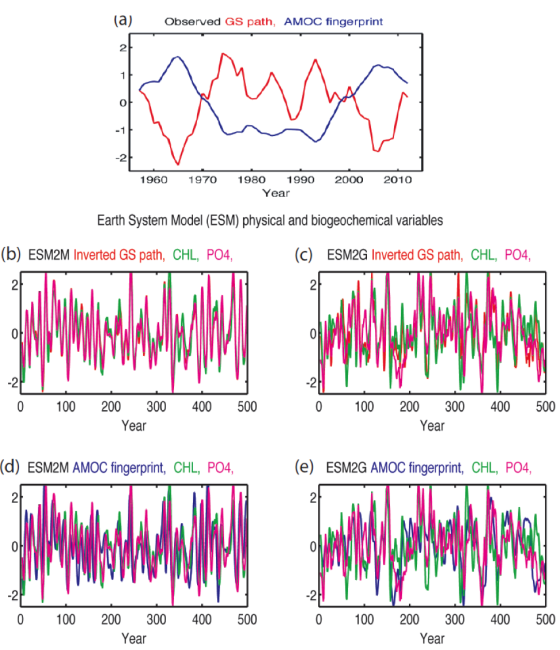AMOC impact on the physical and biogeochemical variability in the Gulf Stream region
The Gulf Stream transports warm salty water from the subtropical region to mid-latitudes in the North Atlantic, and changes in its path can have a strong impact on regional marine ecosystems and fisheries. Understanding the variability of the Gulf Stream path at decadal and longer timescales is crucial for predicting future physical and biogeochemical variations in this region.

In a recent paper, Sanchez-Franks and Zhang show that the underlying physical driver for the decadal variability in the Gulf Stream path and the regional biogeochemical cycling is linked to the low-frequency variability of the large-scale ocean circulation in the Atlantic, also known as Atlantic meridional overturning circulation (AMOC). There is a significant anticorrelation between AMOC variations and the meridional shifts of the Gulf Stream path at decadal timescales in both observations and two Earth system models. The concentrations of chlorophyll (proxy for phytoplankton biomass in the ocean) and nutrient (for phytoplankton growth) in the Gulf Stream region are found significantly correlated with the AMOC strength and anticorrelated with the Gulf Stream path. An enhanced AMOC leads to a stronger cyclonic circulation north of the Gulf Stream and a southward shift of the Gulf Stream path, which results in shallower isopycnals (surfaces of constant density in ocean) in the Gulf Stream front. Nutrient concentrations are higher along the Gulf Stream path in response to the shallower isopycnals and have contributed to the enhanced chlorophyll concentrations around the Gulf Stream path.
The results illustrate how changes in the large-scale ocean circulation, such as AMOC, are teleconnected with regional decadal physical and biogeochemical variations near the east coast of North America. Further, AMOC-induced decadal variability in chlorophyll and nutrient concentrations in the Gulf Stream region might be important for changes in the localized carbon cycle and fisheries at decadal timescales.
Impact of the Atlantic meridional overturning circulation on the decadal variability of the Gulf Stream path and regional chlorophyll and nutrient concentrations (Geophysical Research Letters)
1National Oceanography Centre, UK
2NOAA Geophysical Fluids Dynamics Laboratory
Topics
- Atlantic Ocean
- AMOC
- Ecosystem Impacts
